Samurai's tea culture
Momoyama culture
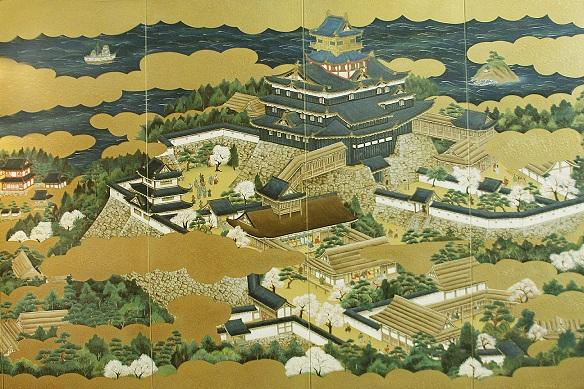
The Azuchi-Momoyama period in Japanese history refers to the age of Oda Nobunaga (1534-1582), who forged the re-unification of Japan under the "tenka fubu (personal seal of Oda Nobunaga from 1567 onward: unify the nation by force)" campaign, and his successor, Toyotomi Hideyoshi (1537-1598), who completed the nation's re-unification. The name is derived from the names of the areas in which the two warlord's castles were located. The culture associated with this period is generally called Momoyama culture. The word Momoyama originates from the site where Hideyoshi built and established Fushimi Castle as his headquarters in the later years of his life. After the castle was abandoned, peach (mono) trees were planted, and the area came to be known as Momoyama.
The Azuchi-Momoyama mollified the conflict of the Sengoku period, which had spanned approximately 100 years, and concentrated power and wealth into a unified political administration. Based on this, the open sensibilities of this period gave birth to the grand and magnificent luxury and ornateness, and the lively new tastes of Momoyama culture.
The spirit of the new daimyo, who had fought through the Sengoku period wars and was now the new ruler of the region, that of the urban merchants who had created great wealth through war and trade, and the power of the economy are all deeply reflected in this culture.
On the other hand, the arrival of Portuguese ships initiated contact with European culture, and this coupled with the influence of brisk foreign expansion of the likes that the Japanese had never engaged in before. The culture of this age became vibrantly colorful and worldly due to the injection of foreign tastes. It was also influenced by Korean and Ryukyu culture through newly arrived ceramics and musical instruments.
Oda Nobunaga
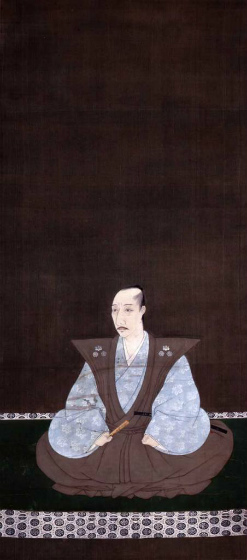 It's no exaggeration to say that the azuchi-Momoyama period (1573-1603) was the era of the Tea Ceremony. One significant charactristic of this period is that the famous general Oda Nobunaga was using tea ceremony culture for politics. We call it as CHANOYU-GOSEIDO.
It's no exaggeration to say that the azuchi-Momoyama period (1573-1603) was the era of the Tea Ceremony. One significant charactristic of this period is that the famous general Oda Nobunaga was using tea ceremony culture for politics. We call it as CHANOYU-GOSEIDO.
During the Warring States Period, Japan was divided into many counties lead by local rulers after the turmoil of the Onin war (1467). Many local rulers had ambitions to dominate the whole country. Oda Nobunaga was also an ambitious person, however he was a minor lord of Owari (present-day Nagoya) a small county on the Pacific side of central Japan.
In 1560 Imagawa Yoshimoto, a more powerful lord invaded Owari with his large force of 25,000 soldiers but Oda defeated him in a surprise attack with only 2,000 soldiers at the battle of Okehazama. After he killed Imagawa, Oda gathered a stronger army and invaided Kyoto, the center of politics, in order to unite the whole country.
In this period local rulers sometime had diplomatic meeting through the medium of the tea ceremony. It was a very important diplomatic tool as through these tea ceremony meetings many wars were averted. Local rulers needed higher class tea ceremony utensils, because having high class tea utensils indicated their national power. Also the tea ceremony was very popular among wealthy merchants in Kyoto and many of them were masters of the tea ceremony.
Oda Nobunaga learned the Tea Ceremony in order to persuade tea ceremony masters to join his faction, then finally he was able to employ them. One of these was Sen no Rikyu. Oda ordered MEIBUTSUGARI at this time. This was a compulsory gathering up of high class tea utensils forced on mainly rich merchants.
Then Oda had diplomatic meeting through the medium of the tea ceremony many times and gave high class tea utensils to subordinates who made outstanding wins in the battles. This was in contrast to the usual practice of giving subordinates territory and shows that Oda had realized that there is a limit on land in Japan. Thus tea ceremony was tied to Japanese culture deeply and became indispensable things.
Meibutsugari - Tea utensils hunting
Oda Nobunaga started to collect tea ceremony utensils in earnest in 1568 when he backed Ashikaga Yoshiaki (younger brother of Shogun 12 th Shogun Ashikaga Yoshiteru who was killed by Matsunaga Hisamichi, Hisahide’s son, in 1565) and marched into the capital. Matsunaga Hisahide, who surrendered to him, and Imai Sokyu, a wealthy merchant of Sakai, presented Nobunaga with tea ceremony utensils, triggering his passion.
Matsunaga Hisahide offered Nobunaga the Tsukumo Nasu (an eggplant-shaped tea caddy called Tsukumo) while Imai Sokyu offered him the tea urn Matsushima and the tea caddy Jo-o Nasub. These were all objects of great value. Nobunaga subsequently ordered Matsui Yukan and Niwa Nagahide to “collect Meibutu (valuable tea utensils) and Karamono (chinese tea utensils), for I have enough gold and silver, rice and money already.” Buying up tea sets through force, he acquired many famous, superb items. In doing so, Nobunaga took care to make sure that money did not find its way to enemy forces and stayed clear of wealthy local merchants who might have connections with such forces. Instead, he built relationships with newly rising forces who were gaining power through trade by collecting valuable tea utensils from them. This can also be considered a means for securing routes to acquire the basic component of gunpowder, saltpeter, which could not be sourced in Japan. Nobunaga was having strong gun-bearing troops.
The famous articles that he collected were also of great use strategically. Nobunaga collected famous tea utensils that already had great value and used these at his tea ceremony parties for truly ostentatious displays of the wealth and power of the Oda regime. Tea utensils that had been displayed during tea ceremony held by ruler Oda Nobunaga rose further in value, which was of great benefit to the coffers of the Oda clan.
Tea sets were also useful in the control of vassals. The possession of famous tea things brought high levels of status, which was equivalent to being awarded a domain and castle.
An episode illustrative of this occurred with Takigawa Kazumasu. As a reward for his attack on Takeda, he was appointed the Deputy of the East and was assigned the whole of Kozuke Province and two districts in Shinano Province. However, even though Kazumasu had been assigned a post and a province, he felt disappointed that he had not received a tea set. He explained, “after defeating Takeda, I was asked what I would like as a reward, and I thought that I’d say ‘a nasubi (tea caddy)." This is not what happened, and I was appointed to such a faraway place that I’ve even lost my taste for chanoyu.”
Incidentally, the five top vassals of Nobunaga were permitted to hold tea ceremony parties. As it was originally prohibited for vassals to hold tea ceremony parties freely, it was a great honor to be bestowed the right to hold one. Such an act was genuine proof of one’s position as a leading figure in the Oda clan entourage. Toyotomi Hideyoshi, who had been permitted to hold tea parties, would apparently shed tears of happiness when he recollected this fact.
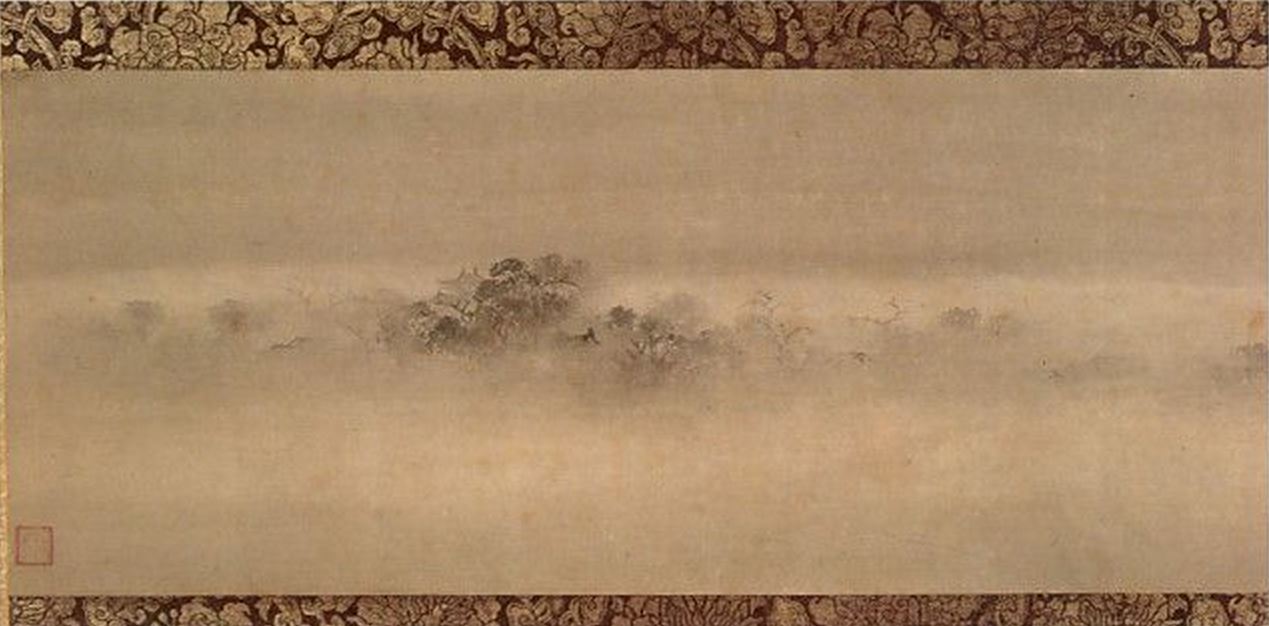
Tsukumo Nasu - The most famous Japanese antique
The "Tsukumo-nasu" is a Chinese-imported ceramic tea container in the nasu ("eggplant" - rounded with a slightly larger bottom) style originally belonging to the third shogun of the Muromachi shogunate, Ashikaga Yoshimitsu (1358-1408). It is said that he even carried it to battle with him. After that it was handed down as a favorite possession through the Ashikaga family for generations. During the time of the eighth Muromachi shogun, Ashikaga Yoshimasa, it was passed into the care of Yoshimasa's master of tea ceremony, Murata Juko.
The tea container began to be called “Tsukumo ninety-nine) nasu" because Juko paid 99 kan (an ancient form of Japanese currency) for it. After that it passed from owner to owner, ever increasing in value.
By the time Asakura Soteki of Echizen got his hands on it it was worth 500 kan. Afterward Asakura entrusted it to the care of wealthy textile merchants in Kyoto, and it is theorized that this was to spare the piece from turmoil in the Echizen region. Around the year Tenbun 16 (1547) it came into the possession of Matsunaga Hisahide, an influential patron of Honkokuji Temple in Kyoto. The exact route it followed is unknown, but he is thought to have paid 1000 kan. However, Hisahide had no choice but to hand over the Tsukumo-nasu to Oda Nobunaga, who had come to Kyoto to pay homage to the shogun's younger brother Ashikaga Yoshiaki, after which he became one of Nobunaga's followers.
It became one of Nobunaga's favorite items, and in the fifth month of Tensho 10 (1582) he took it with him to the capital. It was at his side when he was forced to commit suicide by his own retainer during the Honnoji Incident. Hashiba Hideyoshi (later known as the famous Toyotomi Hideyoshi) took it from the burnt ruins of Honnoji Temple, and it is thought that he passed it down to his son and heir, Toyotomi Hideyori. After that it was kept at Osaka Castle.
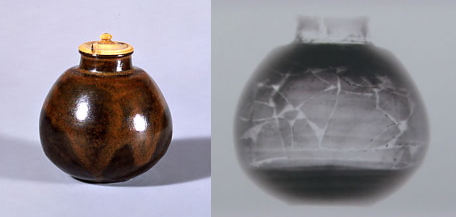
It once again faced the flames of war during the siege of Osaka Castle in the summer of 1615. Tokugawa Ieyasu ordered a search of the ruins, but it was so badly damaged that it was given to a famous lacquer ware craftsman named Fujishige Togen and his son (also named Togen) for repairs, and after Ieyasu's death it as bestowed upon the Fujishige family as a gift, then passed down as an heirloom.
During the Meiji Era it was acquired by Yanosuke Iwasaki of the Mitsubishi Zaibatsu. It is said that Yanosuke borrowed money from his older brother to purchase it.
Hiragumo - Flat spider
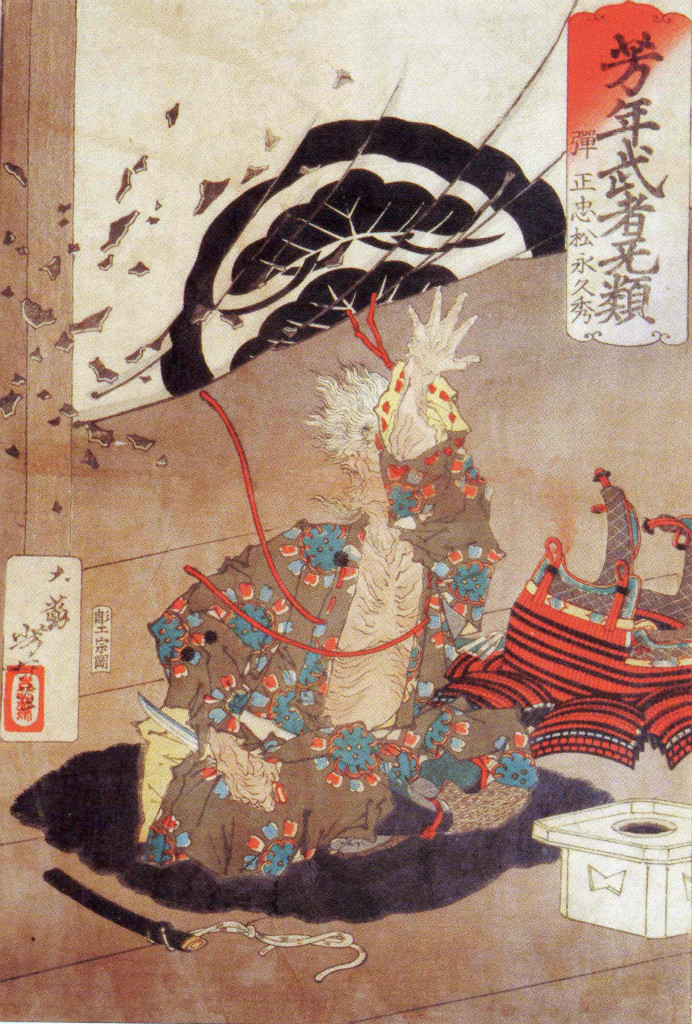 The Kotenmyo Hiragumo Kettle was a famous old kettle owned by the Sengoku period daimyo Matsunaga Hisahide. It received the name hiragumo (flat spider) because, compare to most tea kettles, it was short and flat in shape, like a crawling spider.
The Kotenmyo Hiragumo Kettle was a famous old kettle owned by the Sengoku period daimyo Matsunaga Hisahide. It received the name hiragumo (flat spider) because, compare to most tea kettles, it was short and flat in shape, like a crawling spider.
In 1568, when Oda Nobunaga backed Shogun Ashikaga Yoshiteru’s younger brother Yoshiaki and marched into Kyoto, Matsunaga Hisahide, who was the governor of Kinai (Near Kyoto), immediately surrendered to him and fell under Nobunaga, to whom he had gifted the Tsukumo Nasu. However, even though he was repeatedly pressed by Nobunaga to present him the Hiragumo, he refused to part with the for the remainder of his life.
In 1569, Nobunaga forced the Denchu on okite (a set of regulations that annulled the power of the Shogun) on to Ashikaga Yoshiaki, who had recently become Shogun thank to Nobunaga’s power. In response, Yoshiaki betrayed Nobunaga, concocting the “Oda encircling net” by calling for various daimyo who against Nobunaga to join him. Matsunaga Hisahide approved of the plot and rose against Nobunaga. However, in 1573, Takeda Shingen of Kai Province died from natural causes. As he had been essential to the Oda net, the plot subsequently failed. This incident ended with the surrender of Tamonyama-jo, Hisahide’s castle, and Hisahide fell under Nobunaga for the second time.
In 1577, while Nobunaga was waging a tough battle against the abbot Kosa Kennyo of Honganji Temple, Hisahide committed treason for the second time. He slipped out of the Oda army and confined himself in Shingisan Castle, an act that turned the military situation against him.
Anyone could have predicted Matsunaga Hisahide’s demise, but Nobunaga presented unprecedented terms for surrender: that Hisahide could trade his life for the Hiragumo.
Hisahide refused. Instead, he filled the Hiragumo Kettle with gunpowder, chained it to his neck, and lit it. He blew himself up, ending his life heroically with the Hiragumo.
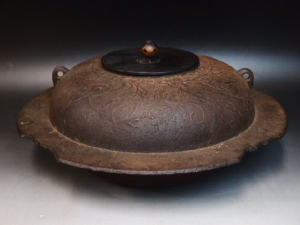
The big three tea caddies - Hatsuhana, Nitta and Narashiba
Chaire, the tea container, is used for thick green tea and it is the most expensive of all the tea ceremony tools. It's a famous story, but during the Warring States period it was said that if you obtained all “The big three chaire (Narashina, Nitta, Hatsuhana) " it would be the same as if you had obtained the whole of Japan. Narashiba was the only one that Oda Nobunaga could not obtain.
Hatsuhana katsuki
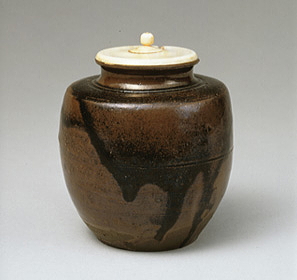
A katatsuki-style tea container imported from China. One of the three most famous katatsuki-style containers. Said to have been one of Yang Guifei's oil jars. Named "hatsuhana (the first flower of the season, or a girl who has just flowered into womanhood)" for its elegance by Ashikaga Yoshimasa. Oda Nobunaga acquired it from the merchants at Daimonjiya for its fame, but lost it in the Honnoji Incident, after which it came to be owned by Toyotomi Hideyoshi. It was inherited by Ukita Hideie after his death, but following Hideie's defeat at the Battle of Sekigahara, it passed into Tokugawa Ieyasu's hands.
Nitta katatsuki
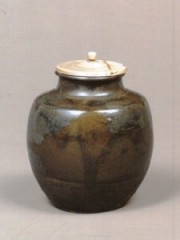
An imported Chinese tea container in the katatsuki (having flattened "shoulders" near the neck) style. One of the three most famous katatsuki-style containers. After Murata Juko acquired it, it was passed to Miyoshi Masanaga, Otomo Sorin, Oda Nobunaga, then Toyotomi Hideyoshi. It became a Tokugawa family heirloom following the fall of Osaka Castle.
Narashiba Katatsuki
This was part of the *Higashiyama-gomotsu and one of the “Big Three Tea Caddies” (Narashina, Nitta, Hatsuhana), and the only one that Oda Nobunaga could not obtain. In the Momoyama period, Narashina's owner was the samurai general Akiduki Tanezame from the Hakata teritory. But Akiduki Tanezane gifted Toyotomi Hideyoshi Narashiba in order to appeal for mercy at a battle in Kyushu in 1587. At this battle Toyotomi Hideyoshi did not use fire in order to avoid destroying Narashine. However, Narashine was unfortunately destroyed by fire during *the Great Fire of Meireki (March 2, 1657).
*Higashiyama-gomotsu
This was the art collection of the Ashikaga shogunate family. It included a great many tea things. This collection was the envy of all tea ceremony masters in the Aduchi-Momoyama period.
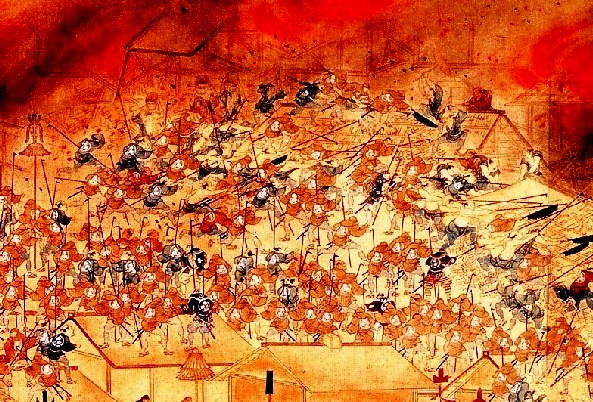 *The Great Fire of Meireki (March 2, 1657)
*The Great Fire of Meireki (March 2, 1657)
Also known as the Furisode Fire, it destroyed 60-70% of the Japanese capital city of Edo (now Tokyo) on March 2, 1657, the third year of the Meireki Imperial era. It lasted for three days, and is estimated to have claimed over 100,000 lives. In addition, many important art objects in Edo city were lost.
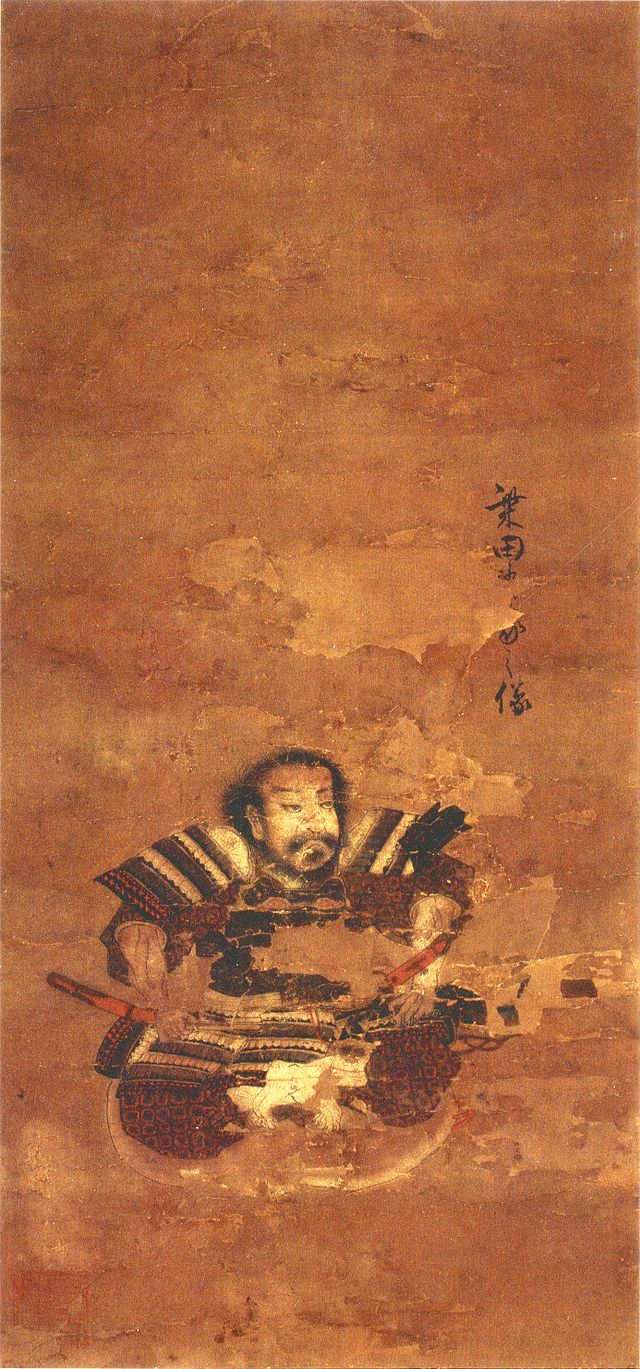
Shibata Ido Tea Bowl
Shibata Katsuie was a military commander who performed great exhibit at most of the major Nobunaga’s battles such as the attack on the Mino Province, the battle against Asai Nagamasa, and the battle of Nagashino, and Nobunaga promoted him to the commander of the conquer of the Hokuriku region. The name Shibata ido tea bowl came from the fact that Shibata Katsuie received the bowl from Nobunaga. The bowl presents the beauty of wide openness. The whole bowl is coated with a pale color like a loquat, and it is partially blue on the inside and outside.
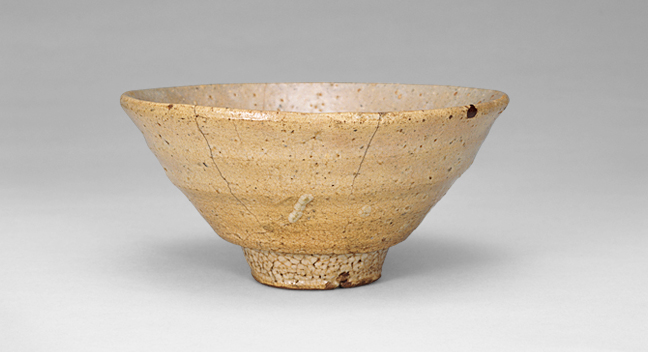
Ranjatai
In 1574, Oda Nobunaga requested permission to cut off a piece of Ranjatai, an unequaled fragrant wood. About five square centimeters were clipped.
Ranjatai is a type of aloeswood, a high-quality fragrant wood grown in southeast Asia. It is said that the wood was brought over from China to Japan during the reign of Emperor Shomu (724 - 749). Ranjatai, now stored in the Shosoin Repository at Todaiji, is sealed with a paper signed by the emperor. Therefore the temple in charge of it cannot open the seal at their discretion; the emperor's permission is required.
Originally, cutting off a piece of Ranjatai was an act reserved for when a shogun was succeeded.
It is said that Emperor Ogimachi raged when he heard Nobunaga's request to cut off a piece, but he was unable to defy Nobunaga and reluctantly approved. This proves how absolute Nobunaga's authority was at this time.
So far those who have cut off a piece of Ranjatai include Ashikaga Yoshimitsu, Ashikaga Yoshinori, Ashikaga Yoshimasa, Toki Yoritake, Oda Nobunaga, and Emperor Meiji. The papers seen in the photograph contain the names of those who have cut off a piece of Ranjatai.
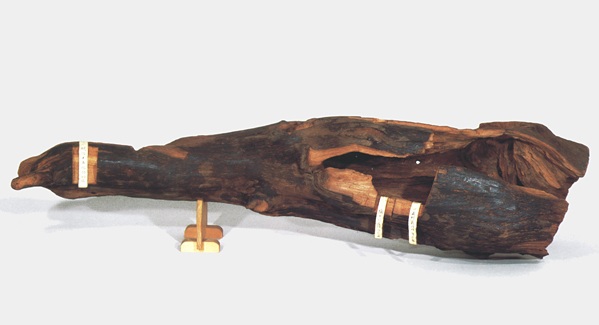
Shoka
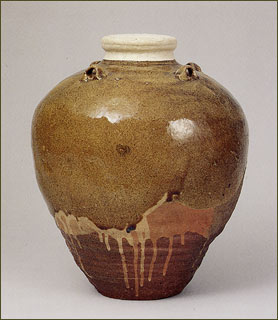
For tea ceremony masters, the chatsubo or tea leaf jar, was an extremely expensive tea ceremony item. They evolved from herb containers imported from the Philippines and Vietnam, however in Japan the containers were used as tea utensils. Shouka, means "pine flower", is a very famous tea leaf jar that was made in China in the 13th century and inported via Luzon. The tea ceremony founder Murata Juko recognized Shouka's beauty and the Ashikaga shognate also recongnized it and took it into the Higashiyama-gomotsu (collection of the shougnate). The Mikaduki (crescent) chatsubo and Matsushima chatsubo were also so beautiful that, together with Shoka, the three were called the “Big Three tea jars”. In particular, Mikaduki was the most popular among tea ceremony masters.
In the momoyama periodo, Oda Nobunaga obtained all "big three tea jars" but Mikaduki and Matsushima were destroyed by fire in the Honnoji Incident. Off the subject, Oda's samurai general Toyotomi Hideyoshi made large profit importing these herb containers as tea leaf jars.
Honnoji Incident (June 21, 1582)
This was the forced suicide of Oda Nobunaga at Honnoji temple in Kyoto, ordered by his samurai general Akechi Mitsuhide. Oda Nobunaga used fire at this battle. Unfortunately many valuable tea utensils were destroyed by fire because Oda had held a tea ceremony the previous day. Oda's samurai general Toyotomi Hideyoshi was in battle against Mori clan at Bicchu. He kept the incident secret, quickly made peace with the Mori clan, and returned to the Kinai region to search out and destroy Akechi. Hideyoshi succeeded to Oda's forces after defeating Akechi Mitsuhide in the battle of Yamazaki (July 2, 1582). The treason by Akechi ended in a relatively short-lived rule.
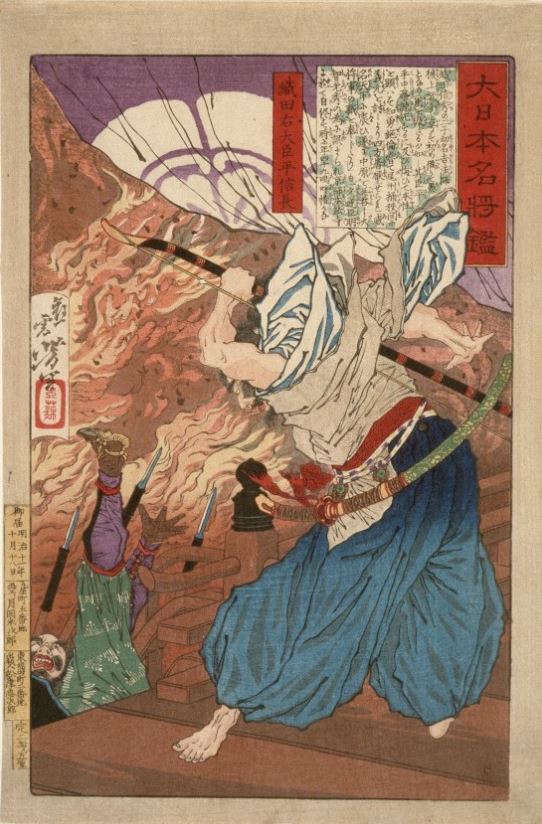
Kitano daisanoe – The big tea ceremony party by Toyotomi Hideyoshi
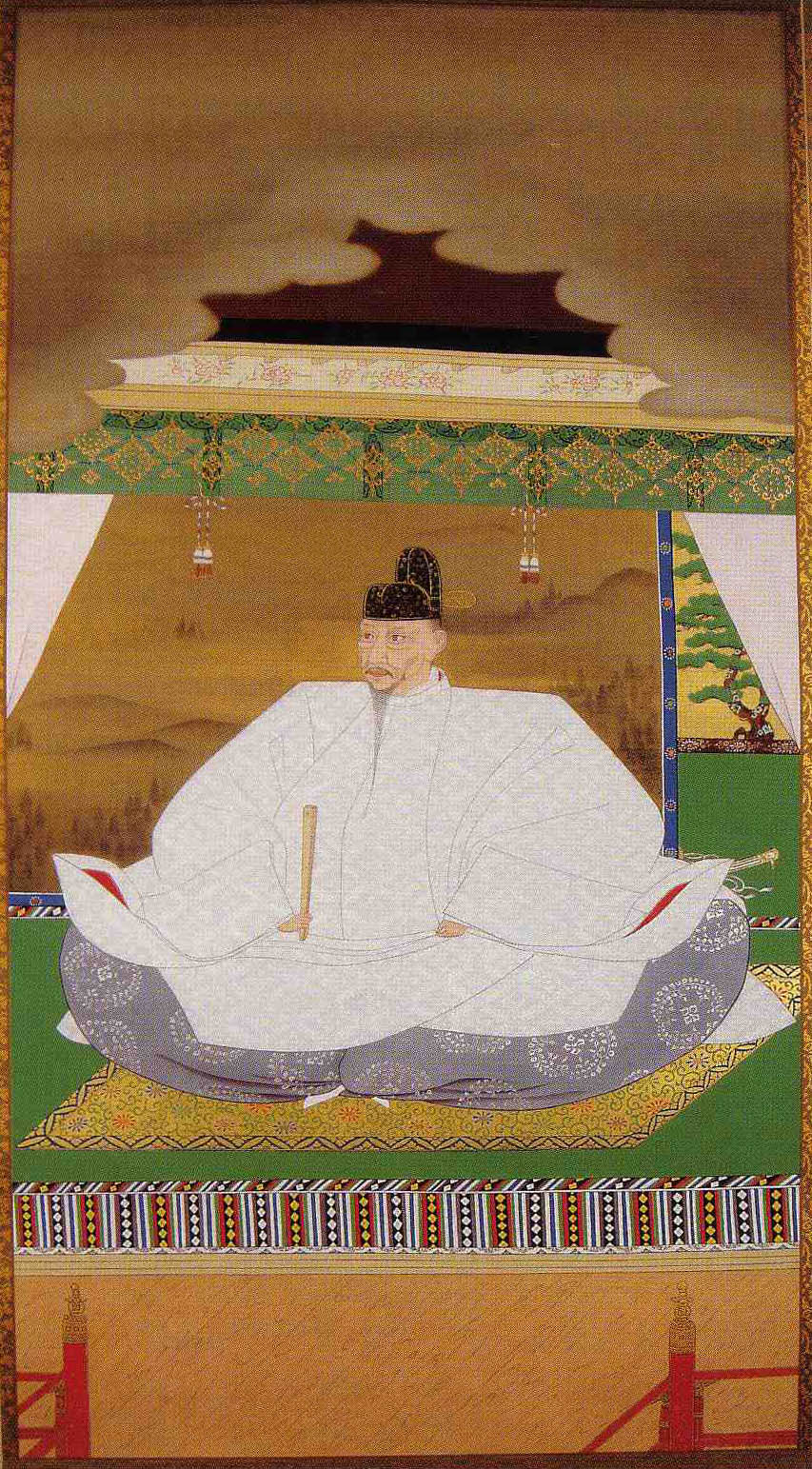
Kitano-daisanoe was a large-scale tea party held on November 1st, 1587 by the then Regent and Chancellor of the Realm Hideyoshi Toyotomi in the grounds of Kitano Tenmangu shrine, in Kyoto. Hideyoshi, who had completed his Kyushu region Campaign in July of that year, planned this large-scale event in order to show his authority to the Imperial Court and general public of Kyoto.
On the day of the tea party, the hall of worship at Kitano Tenmangu was separated into three areas, at the center of which was placed a golden tea room, with Hideyoshi's own range of treasured items (such as the "Eggplant Resembling" porcelain) on display. Also, as an accompaniment for the tea, sweets such as crackers made from wheat gluten, and Shinseimame, were served.
On that day, a great number of participants gathered not only from Kyoto but from Osaka, Sakai, and Nara, and it is said that over 800 separate tea rooms were set up in the grounds.
In four tea rooms, in addition to Hideyoshi, three of the most prominent tea ceremony masters of the time, Sen no Rikyu, Tsuda Sogyu, and Imai Sokyu, were invited to preside. The participants, regardless of social class, were invited to the tea rooms in groups of three to five by the drawing of lots, and were served tea using Hideyoshi's treasured utensils. It is said that Hideyoshi spent his day, serving tea himself as the tea master in the morning, and going around the party, looking very satisfied, in the afternoon.
This tea party, which was advertised as "tea ceremony enthusiasts must participate, whether foot-soldiers, tradesmen, or farmers, bringing along a pot, a bucket, a cup, or, for those without tea ceremony utensils, anything that can take their place", had a great impact on the popularity of tea ceremonies at the time.
Ogon chashitsu & Taian
This golden tea ceremony room was made by Toyotomi Hideyoshi. It is quite the opposite to the very plain ‘Taian’ tea ceremony room of Sen no Rikyu.
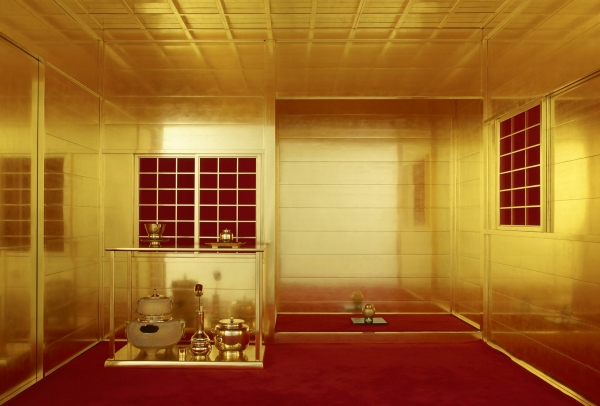
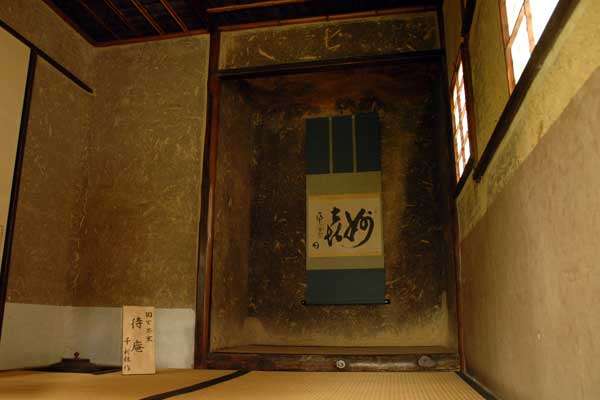
Chidori - Incense burner
This is a celadon longquan-ware incense burner, once owned by Toyotomi Hideyoshi. An anecdote about Ishikawa Goemon is relevant to Chidori. He was ordered to assassinate Toyotomi Hideyoshi by Kimura Hitachinosuke, a vassal of Toyotomi Hidetsugu (Hideyoshi’s nephew). One night Ishikawa Goemon finally succeeded in creeping into Hideyoshi’s bed room in Fushimi castle. But Hideyoshi realized Goemon was there because suddenly Chidori 'singing'. Ishikawa was caught by Hideyoshi’s samurai who ran to the scene, and he was then boiled to death in a cauldron (Kamayude) at Sanjogawara in Kyoto.
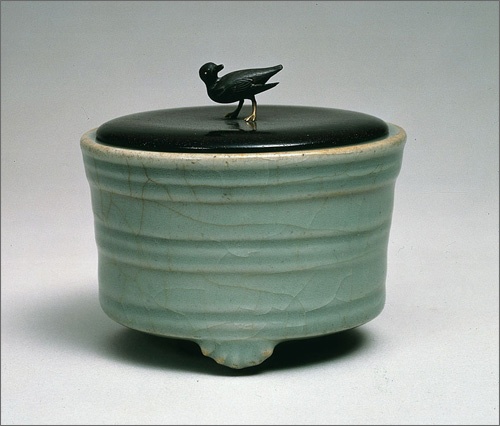
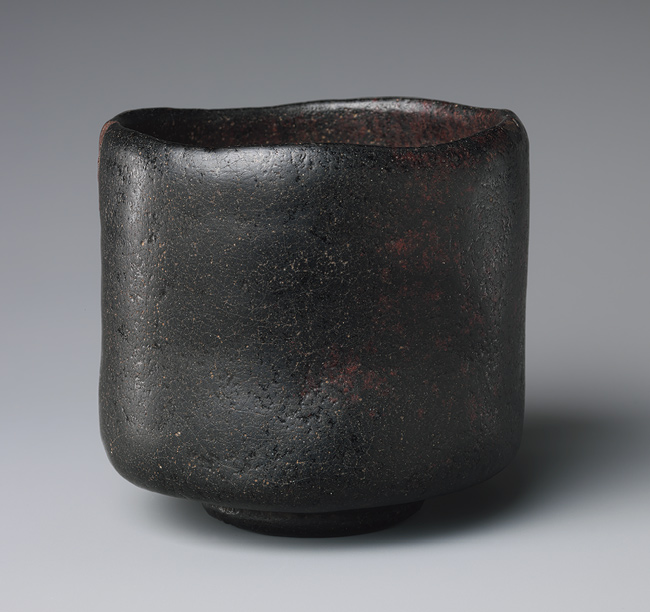
Kuro Raku Chawan
Raku ware is a type of pottery that is traditionally and primarily used in the Japanese tea ceremony, most often in the form of tea bowls called Raku chawan. In the Momoyama era (1568-1603), the first raku chawan was made by famous artist Raku Chojiro, the founder of Raku ware, after receiving orders from Sen no Rikyu, Japan's most famous Tea Ceremony artist. Rikyu also served ruler Toyotomi Hideyoshi. In the late Momoyama era, Rikyu ordered Raku Chojiro to make kuro raku chawan. Kuro means black in Japanese. Hideyoshi disliked black, and Rikyu ordered the black bowls knowing this. It is also said that Rikyu did this because Hideyoshi was considering invading Korea at that time. Sen no rikyu was against Hideyoshi actually. Unfortunately Hideyoshi ordered Rikyu to commit ritual suicide (seppuku) for another reason. After he died, his philosophy, "wabi" lived on with the black Raku bowls. Raku ware became one of the famous Tea Ceremony bowl styles to the present day. Wabi means accepting imperfection. This is a beautiful Japanese philosophy.
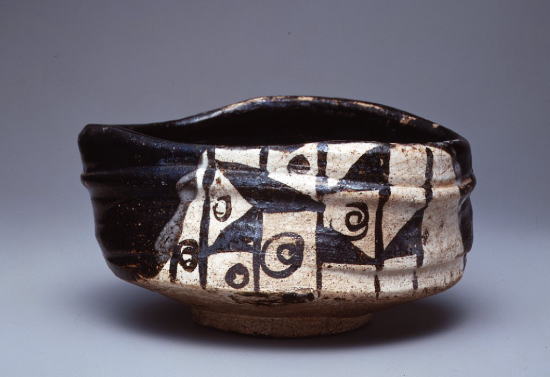 Oribe
Oribe
Oribe ware is a type of Japanese pottery most identifiable for its use of green copper glaze, mat black and bold painted designs. It was the first use of colored stoneware glaze by Japanese potters. It takes its name from tea master Furuta Oribe (1544-1615).Oribe ware has quite strange shapes. It was an innovative style at the time. It is said that the strange styles were made under Oribe's direction. He was pupil of Sen no Rikyu, Japans's most famous Tea Ceremony artist. In the Momoyama period, Rikyu was serving under ruler Toyotomi Hideyoshi, while Oribe was serving under rival Tokugawa Ieyasu. In the battle of Osaka Natsu no Jin (1615), Tokugawa's troops defeated Toyotomi's. Thus Tokugawa became the ruler of Japan. Unfortunately he ordered Oribe to commit ritual suicide (seppuku) as a suspected spy of Toyotomi.
In the present day, Oribe ware is very popular with Japanese antique collectors for its historical atmosphere and strange shapes.

Ankoku-ji tea caddy
This old Chinese tea caddy found in Ankoku-ji was first called the Ariake tea caddy, said to be one of Toyotomi Hideyoshi's cherished items which he later passed down to Hosokawa Sansai (also known as Tadaoki, one of the founders of the Sansai branch of tea ceremony). However, Sansai had to sell it due to his financial difficulties. It finally came into possession of Ankokuji Ekei, which is why it has become known as the Ankoku-ji tea caddy. After serving at the Battle of Sekigahara, Ekei was executed in the Shijō Kawaramachi streets of Kyoto, and following his wishes as stated prior to the war, his antique tea caddy was given to Tsuda Koheiji by Tokugawa Ieyasu.
Then during one of Tsuda's tea parties, Sansai, who had been invited, came across his old tea caddy and could not repress the desire to take it with him. He waited until the host went to the kitchen, secretly hid it in his breast pocket and wrote down Saigyō Hōshi's poem
'I never thought I would cross Sayo no Nakayama ever again. I could do this because I am still alive' as a note for Tsuda and left. It is because of this that yet another of its names is the Nakayama tea caddy.
Upon getting back home, Sansai sent a servant to gift Tsuda with 200 golden coins from his personal supply, together with food and drink, and apologized for his impoliteness. He asked to be allowed to keep his tea caddy. Tsuda was impressed by this enthusiasm and let him keep it. However, he did not accept the gold, so in the end Sansai used it to erect a Buddhist temple.
In 1627, due to a famine breaking out in the Kokura Domain within the Buzen Province (Fukuoka Prefecture), Hosokawa Tadatoshi, the third head to the Buzen Kokura Domain and Sansai's successor, exchanged the temple for 1500 golden coins and thus managed to save his starving people.
It is said that Sansai, who was in Edo at the time, heard this and praised him with the words "With this, Tadatoshi's tea ceremony has also improved".
From then onwards the tea caddy passed onto Sakai Tadakatsu, the feudal lord of the Tsuruoka Domain, and in 1865 his son presented it to the shogunate; then later it came under protection of the lord of Ueda Castle, Matsudaira Iga-no-kami. Since then, it became a hereditary item handed down through the Matsudaira family, but in
1913 they auctioned it off and Masuda Eisaku was the winning bidder. At the time, the Matsudaira clan didn't have many possessions so the tea caddy didn't attract much attention, and was acquired for the small amount of 800 yen.

Tokugawa Ieyasu, one of the Council of Five Elders, started to enhanced his influence in the Toyotomi administration when Toyotomi Hideyoshi died in 1598. When former member of the Five Commissioners Ishida Mitsunari and others revolted in 1600, Ieyasu commanded the eastern army to victory over Mitsunari and the western army in the Battle of Sekigahara. Tokugawa Ieyasu took over power, leading the post-war settlements and performing the distribution of honors. During this time, the area ruled by the Toyotomi clan was disposed, and the their territory was reduced to Settsu, Kawachi, and Izumi, an area of about 650,000 koku (area yielding about 97,500 tons of rice).
In March 24, 1603, Ieyasu was appointed as the shogun. The Edo shogunate began, and Japan entered the stable Edo period.
The Toyotomi clan collapsed when they lost the Siege of Osaka, Osaka no Jin, which occurred from 1614 to 1615.